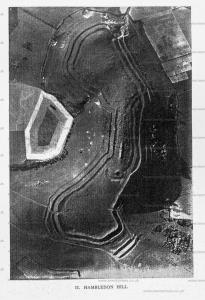South England Neolithic Causewayed Enclosures
South England Neolithic Causewayed Enclosures is in South England Neolithic, Causewayed Enclosure.
Europe, British Isles, South-West England, Dorset, Child Okeford, Hambledon Hill Causewayed Enclosure [Map]![]()
Around 2850BC. Hambledon Hill Causewayed Enclosure [Map] is two causewayed enclosures linked by a bank and ditch running northwest-southeast. A third enclosure is now known to underlie later earthworks. In all, the area of activity covered more than 1 km2. Radiocarbon analysis gives a date of 2850 BC - see Hambledon Hill Causewayed Enclosure Carbon Dates.
Wessex from the Air Plates 2 and 3. Hambledon Hill [Map]. By Eric Gardner, M.B. (Cantab.), F.S.A.

Europe, British Isles, South-Central England, Oxfordshire, Uffington, Rams Hill Causewayed Enclosure [Map]![]()
Rams Hill Causewayed Enclosure is also in Iron Age Hill Forts Oxfordshire.
1200BC. Rams Hill [Map] is a possible causewayed enclosure although the date 1200BC suggests an early Iron Age Hill Fort:
A multi‐period enclosure site on the Berkshire Downs of south Oxfordshire overlooking the Vale of the White Horse and the middle Thames Valley. Extensively excavated between 1972 and 1975 by Richard Bradley and Ann Ellison, the site has four main structural phases and is critical for understanding the early development of hillforts in southern Britain. The earliest phase dates to the early 12th century bc and comprised a stone‐faced dump rampart inside a chalk‐cut ditch that defined a roughly oval‐shaped enclosure of about 1 ha. There were probably two or three entrances. In phase 2, the late 12th century bc, a timber‐laced rampart was constructed to replace the earlier defences. In the third phase, around the beginning of the 10th century bc, a double palisade was built on top of the former, by this time mainly silted‐up, ditch. In the final phase, dated to the 7th century bc, a much larger enclosure of 3.5 ha was built around the hilltop in the style of early hillforts. R. Bradley and A. Ellison, 1975, Ram's Hill: a Bronze Age defended enclosure and its landscape. Oxford: British Archaeological Reports British Series 19
Europe, British Isles, South-West England, Wiltshire, Stonehenge Landscape, Stonehenge Monuments and Burials, Robin Hood's Ball Enclosure [Map]![]()
Robin Hood's Ball Enclosure is also in Stonehenge Neolithic.
4000BC. Robin Hood's Ball Enclosure [Map] is a Causewayed Enclosure constructed around 4000BC and in use until 3000BC around 4.3km north-west of Stonehenge standing on a low hill affording views in all directions including Stonehenge. It has one causeway.
Carbon Date. 2740BC. Late Neolithic Carbon Dates
Report: Bone: Bos
ID: 4995, C14 ID: OxA-1400 Date BP: 4740 +/- 100, Start Date BP: 4640, End BP: 4840
Abstract: Robin Hood's Ball [Map], England
Archaeologist Name: Richards
Reference Name: Archaeometry 31(2), 1989, 207-234
Council for British Archaeology (2012) Archaeological Site Index to Radiocarbon Dates from Great Britain and Ireland [data-set]. York: Archaeology Data Service [distributor] https://doi.org/10.5284/1017767
Carbon Date. 2510BC. Late Neolithic Carbon Dates
Report: Bone: Bos
ID: 4996, C14 ID: OxA-1401 Date BP: 4510 +/- 90, Start Date BP: 4420, End BP: 4600
Abstract: Robin Hood's Ball [Map], England
Archaeologist Name: Richards
Reference Name: Archaeometry 31(2), 1989, 207-234
Council for British Archaeology (2012) Archaeological Site Index to Radiocarbon Dates from Great Britain and Ireland [data-set]. York: Archaeology Data Service [distributor] https://doi.org/10.5284/1017767
Colt Hoare 1812. Iter IV. Starting once more From my head quarters at Amesbury, I shall direct my course towards KNIGHTON LONG BARROW [Map], which, from its elevated situation on a high ridge of land, rivals, if not surpasses, ELL BARROW in preminence of prospect, The first object of our attention: near a clump of trees called ROBIN HOOD BALL [Map], is one those ancient circles, which I have before mentioned and described in the Heytesbury Station, p. 80, This, like the generality of them, is placed on an elevated and commanding situation, but has this peculiarity, of having one circle within the other, with an entrance towards the north. We have to regret the great injury these circles have sustained by the plough, as in their original state they must have been highly curious, and are the more remarkable, from representing a double circle.